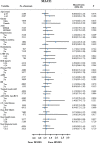Impact of current smoking on 2-year clinical outcomes between durable-polymer-coated stents and biodegradable-polymer-coated stents in acute myocardial infarction after successful percutaneous coronary intervention: Data from the KAMIR
- PMID: 30289945
- PMCID: PMC6173404
- DOI: 10.1371/journal.pone.0205046
Impact of current smoking on 2-year clinical outcomes between durable-polymer-coated stents and biodegradable-polymer-coated stents in acute myocardial infarction after successful percutaneous coronary intervention: Data from the KAMIR
Abstract
Objective: Data concerning the effect of current smoking on solely new-generation drug-eluting stents (DES) are limited. We investigated the impact of current smoking on 2-year clinical outcomes between durable-polymer (DP)-coated DES (zotarolimus-eluting [ZES] and everolimus eluting [EES]) and biodegradable-polymer (BP)-coated biolimus-eluting stent (BES) in acute myocardial infarction (AMI) patients after successful percutaneous coronary intervention (PCI).
Methods: Finally, a total of 8357 AMI patients with current smoking underwent successful PCI with new-generation DES (ZES, EES, and BES) were enrolled and divided into three groups as ZES (n = 3199), EES (n = 3987), and BES group (n = 1171). The primary endpoint was the occurrence of major adverse cardiac events (MACE) defined as all-cause death (cardiac death [CD] or non-cardiac death), recurrent AMI (re-MI), any revascularization (target lesion revascularization [TLR], target vessel revascularization [TVR], and non-TVR). The secondary endpoint was the incidence of definite or probable stent thrombosis (ST).
Results: The 2-year adjusted hazard ratio (HR) of MACE for ZES vs. EES (1.055; 95% confidence interval [CI], 0.843-1.321; p = 0.638), ZES vs. BES (HR, 0.885; 95% CI, 0.626-1.251; p = 0.488), EES vs. BES (HR, 0.889; 95% CI, 0.633-1.250; p = 0.499), and ZES/EES vs. BES (HR, 0.891; 95% CI, 0.648-1.126; p = 0.480) were similar. The occurrence of ST after adjustment were also comparable. In addition, the 2-year adjusted HR for all-cause death, CD, re-MI, TLR, TVR, and non-TVR were not different.
Conclusions: In this study, DP-DES and BP-DES showed comparable safety and efficacy during 2-year follow-up periods. Therefore, DP-DES or BP-DES are equally acceptable in AMI patients with current smoking undergoing PCI.
Conflict of interest statement
The authors have declared that no competing interests exist.
Figures




Similar articles
-
Two-year clinical outcomes of zotarolimus- and everolimus-eluting durable-polymer-coated stents versus biolimus-eluting biodegradable-polymer-coated stent in patients with acute myocardial infarction with dyslipidemia after percutaneous coronary intervention: data from the KAMIR.Heart Vessels. 2019 Feb;34(2):237-250. doi: 10.1007/s00380-018-1251-0. Epub 2018 Aug 30. Heart Vessels. 2019. PMID: 30167772
-
Comparison of Durable-Polymer- and Biodegradable-Polymer-Based Newer-Generation Drug-Eluting Stents in Patients with Acute Myocardial Infarction and Prediabetes After Successful Percutaneous Coronary Intervention.Int Heart J. 2020 Jul 30;61(4):673-684. doi: 10.1536/ihj.19-654. Epub 2020 Jul 18. Int Heart J. 2020. PMID: 32684595
-
Safety and efficacy profile of bioresorbable-polylactide-polymer-biolimus-A9-eluting stents versus durable-polymer-everolimus- and zotarolimus-eluting stents in patients with acute coronary syndrome.Catheter Cardiovasc Interv. 2016 Nov 15;88(6):E173-E182. doi: 10.1002/ccd.26617. Epub 2016 Jul 5. Catheter Cardiovasc Interv. 2016. PMID: 27377554
-
Clinical outcomes with bioabsorbable polymer- versus durable polymer-based drug-eluting and bare-metal stents: evidence from a comprehensive network meta-analysis.J Am Coll Cardiol. 2014 Feb 4;63(4):299-307. doi: 10.1016/j.jacc.2013.09.061. Epub 2013 Nov 6. J Am Coll Cardiol. 2014. PMID: 24211507 Review.
-
Efficacy and safety of everolimus and zotarolimus-eluting stents versus first-generation drug-eluting stents in patients with diabetes: A meta-analysis of randomized trials.Int J Cardiol. 2017 Mar 1;230:310-318. doi: 10.1016/j.ijcard.2016.12.116. Epub 2016 Dec 27. Int J Cardiol. 2017. PMID: 28062139 Review.
Cited by
-
Patient-Related Factors Predicting Stent Thrombosis in Percutaneous Coronary Interventions.J Clin Med. 2023 Nov 28;12(23):7367. doi: 10.3390/jcm12237367. J Clin Med. 2023. PMID: 38068419 Free PMC article. Review.
-
Primary percutaneous coronary intervention in CAD patients: A comparison of major adverse cardiovascular events of second- and third-generation drug-eluting stents.Front Pharmacol. 2022 Nov 16;13:900798. doi: 10.3389/fphar.2022.900798. eCollection 2022. Front Pharmacol. 2022. PMID: 36467026 Free PMC article.
-
Real-World Three-Year Clinical Outcomes of Biolimus-Eluting Stents versus Other Contemporary Drug-Eluting Stents in Patients with Acute Myocardial Infarction Patients: Data from the Korea Acute Myocardial Infarction Registry (KAMIR).J Interv Cardiol. 2021 Jul 20;2021:6698582. doi: 10.1155/2021/6698582. eCollection 2021. J Interv Cardiol. 2021. PMID: 34366721 Free PMC article.
-
Sex difference after acute myocardial infarction patients with a history of current smoking and long-term clinical outcomes: Results of KAMIR Registry.Cardiol J. 2022;29(6):954-965. doi: 10.5603/CJ.a2020.0185. Epub 2021 Jan 13. Cardiol J. 2022. PMID: 33438183 Free PMC article.
References
-
- Burns DM, Epidemiology of smoking-induced cardiovascular disease. Prog Cardiovasc Dis. 2003;46(1):11–29. . - PubMed
Publication types
MeSH terms
Substances
LinkOut - more resources
Full Text Sources
Medical
Miscellaneous

